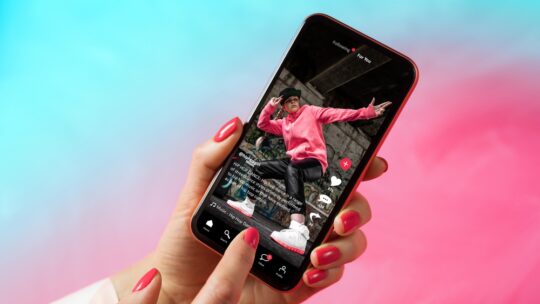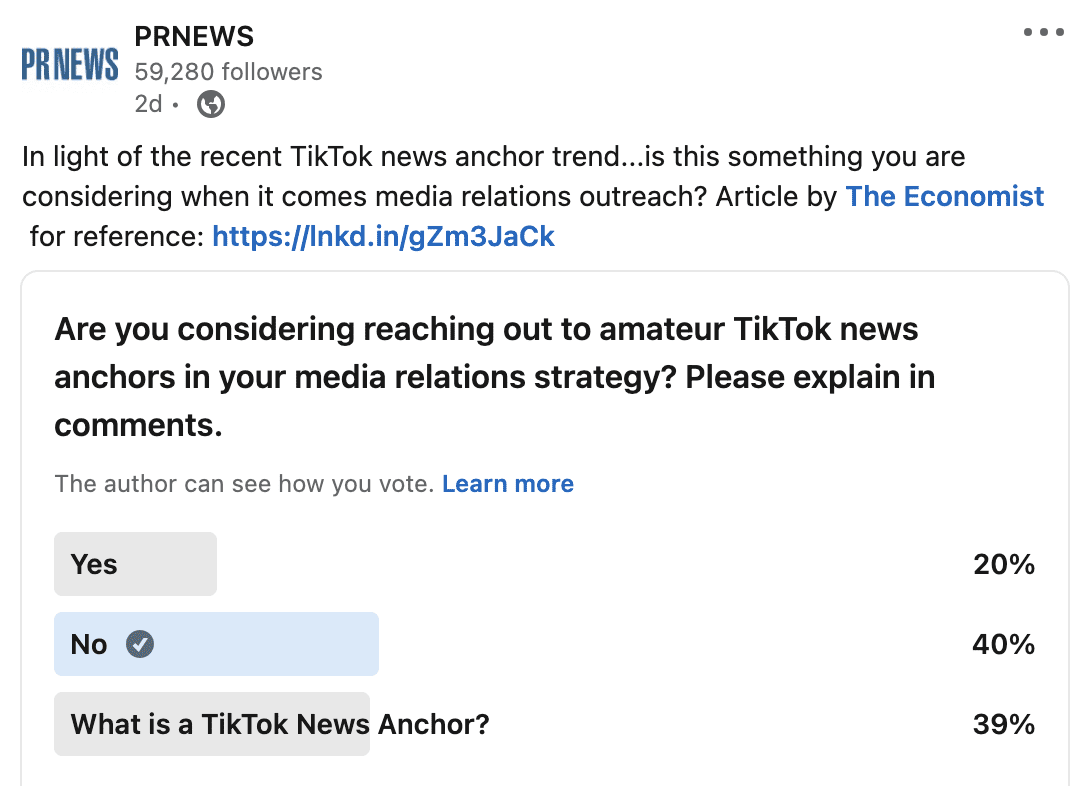
As traditional newsrooms shrink, and media outlets are bought, sold, condensed or evaporated, Americans may have to look elsewhere for news. In fact, a Pew Research Center 2023 study found news consumption habits to be shifting—particularly amongst Gen Z. The findings revealed that 32 percent of adults under 30 say they regularly get news on TikTok.
These findings support a recent article that caught our attention in The Economist: “The Rise of the TikTok News Anchor.” The article highlights three specific accounts, one called “News Daddy,” with more followers than The New York Times, The Washington Post and The Daily Mail combined; one with a talking fish delivering headlines; and another of a college student saying “the Iowa caucus is ‘just tea, it’s gossip.’”
Our piqued interest in these emerging formats got us thinking about media relations and forced our hand to conduct an informal poll on LinkedIn: “Are you considering reaching out to amateur TikTok news anchors in your media relations strategy?"

While a majority did not consider TikTok news analysts to be significant enough for outreach (and almost 40 percent had not even heard of the phenomenon), a solid 20 percent of respondents are looking at this medium when it comes to their media relations plans.
A New Opportunity for Media Relations
This shift in media consumption habits presents a unique opportunity for PR professionals. TikTok news anchors may help communicators to reach Gen Z in a way that traditional media outlets cannot.
Monique Kelley, an associate professor at Boston University’s College of Communication and strategic corporate communications consultant, says TikTok should be leveraged for companies and brands with audiences on that platform, as it’s not suitable for everyone.
“I teach Media Strategies & Management. My first lecture [this semester] to the students was on the process behind media relations. We first must (1) find the news, (2) identify the appropriate audience for that news and (3) communicate the news to that audience through the channels that reach them.”
Matt Prince, Head of PR at Taco Bell, knows the brand’s audience well, and says it’s important for these personalities to get the information directly from the source.
“Gen Z is not going to the news, the news is coming to them, and usually through their FYP (For You Page on TikTok) from influencers, content creators and TikTok news sources. Why not better arm them with the resources, assets and access typically reserved for journalists?
"If traditional PR leaders are waiting for them to conform to conventional news values, they will be waiting a long time and eventually fall behind…This shift will happen with or without PR, might as well get on board and help shape the trends while you still can!”
Hard NOs
However, there can be challenges associated with engaging TikTok news anchors. They are not always trained journalists, and may not always adhere to the same standards of accuracy and objectivity as traditional reporters and anchors. Additionally, TikTok news anchors can be controversial, and their content may not always be appropriate for all audiences.
Andrew Graham, founder of Bread & Law and former PRSA-NY president, does not trust this strategy yet for his practice.
“It's a hard no from me. It strikes me as a bad idea to just assume that amateurs on any platform will obey conventional news values.
"I don't necessarily dislike that this is evidently a thing; I'm just not incorporating it into my work and probably won't anytime soon. It's one of those situations where the best approach is to just monitor and do absolutely nothing else.”
Diane Blackman, co-founder and president at BRPR emphatically rejects the idea as well, choosing to go a more traditional route with learned reporters.
“Absolutely not. We will stick with respected media that abides by the tenants of good journalism.”
Positive Outcomes
Some practitioners, like Shane Collins, Brand and Product Communications at Grammarly, liken the shift to the early influencer movement. Trying out a new method in 2010 worked out, so Collins feels like testing and staying ahead of the trends on different platforms can yield positive results.
“In 2010, my team applied the principles of a traditional journalist FAM (familiarization) tour to a set of "social media influencers"—and the results blew my client's mind. Engagement and followers on their social channels started to skyrocket. New customers started engaging with influencer content about the brand, opening doors directly to their audience. We were told no one would get on board with the idea, and 14 years later, "Influencer Engagement" is an actual marketing discipline.
"The same thinking applies here. These influencers weren't trained journalists by any means—and as a PR professional, my value to them was tremendous. TikTok news anchors are reaching Gen Z in a way that drives them to action. I liken it to using AI—you can be skeptical, but if you don't learn it, someone else will, and you'll be passed by. This segment of influencers is a growing source of direct audience engagement, and one that I predict may also help tie PR results to the bottom line.”
Nicole Schuman is senior editor for PRNEWS. Follow her: @buffalogal
